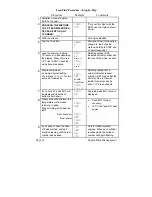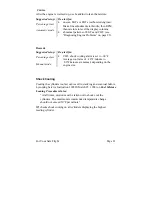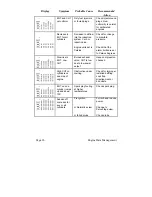
Page 28
Engine Data Management
When an alarm is displayed,
holding
the
STEP
button until the word
OFF
appears will disable that alarm indication for the remainder of the
flight. See “Alarm Limits” on page 44.
Alarm Priority
If multiple alarms occur simultaneously, the higher priority alarm will
temporarily “mask” the lower priority alarm(s). When an alarm occurs,
note the cause of the alarm and tap the
STEP
button to clear the alarm
indication so that you will be notified of any other alarm that might have
occurred. The alarm priorities are as follows:
Highest priority
CHT
High CHT
OIL
High OIL temperature
TIT
High TIT
OIL
Low OIL temperature
CLD
EXCESSIVE CHT
COOLING RATE
DIF
Excessive EGT span
BAT
High battery voltage
BAT
Low battery voltage
MAP
Overboost Manifold pressure
LO
FUEL
Low fuel quantity remaining
Lowest priority
LO
TIME
Low fuel endurance remaining
Pre-Ignition and Detonation
Combustion that is too rapid leads to detonation and possibly pre-ignition.
Detonation
is abnormally rapid combustion where the fuel-air mixture
explodes instead of burning uniformly. It causes the EGT to decrease and
the CHT to increase, and can appear during the leaning process. It occurs
under high compression from fuel with too low an octane rating, or from
avgas contaminated by jet fuel. Fuel additives, such as lead, boost the
octane rating and slow down the combustion process, producing an even
pressure to the piston.
Pre-ignition
is caused by hot spots in the cylinder. Ignition occurs prior
to the spark plug firing. The EDM depicts pre-ignition as a sudden red
line of the EGT on the analog display. This may occur in one or more
cylinders. The affected cylinder column(s) will flash while the digital
display will show an EGT higher than 2000°F.
At this temperature pre-







































